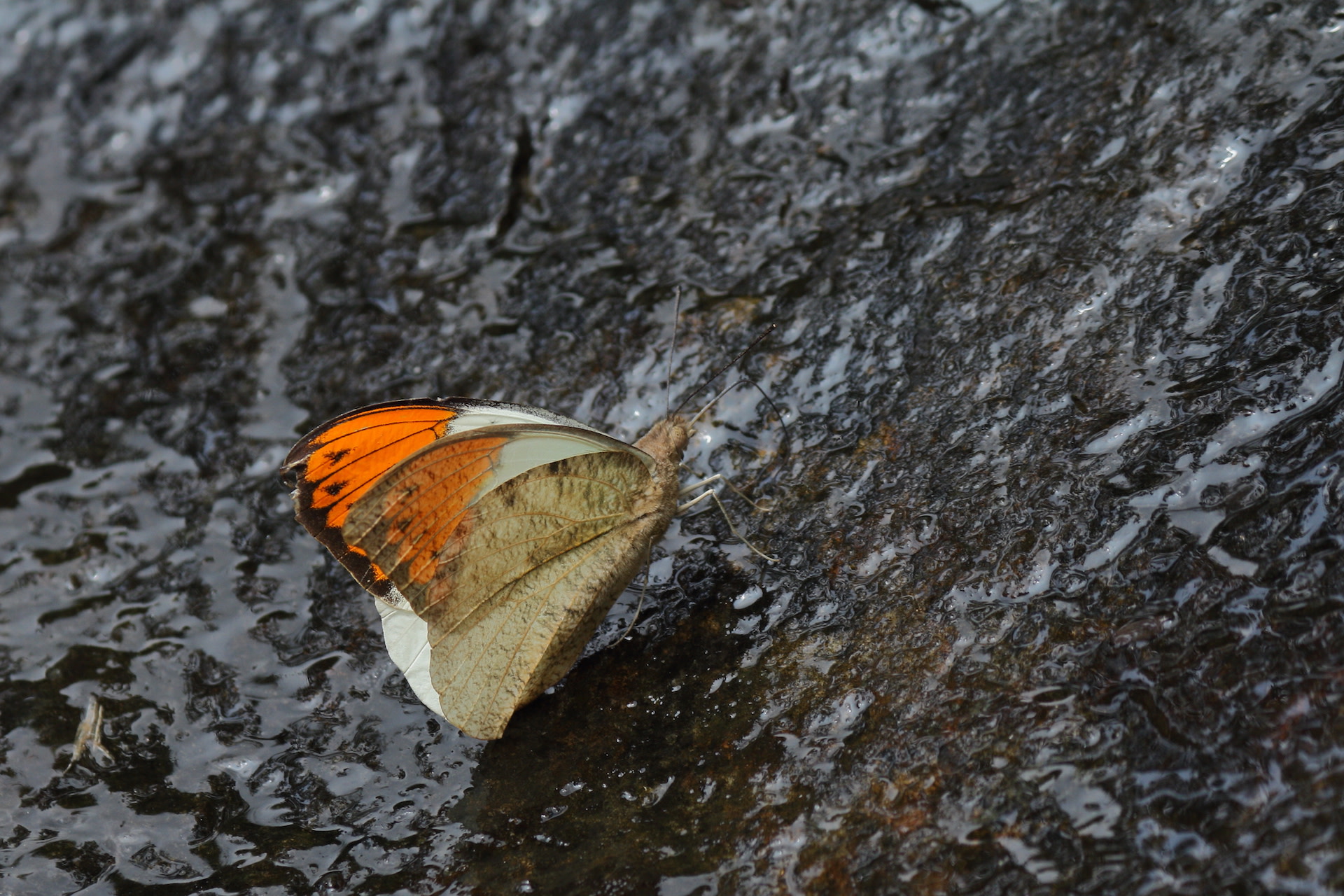 Listen to this article
•
15:34 min
Listen to this article
•
15:34 min
I see moth wings strewn on the floor under my desk every morning. The litterbug is a butterfly-sized long-eared bat. While I sleep through the night, this little creature goes to work at my office. I had imagined the discarded parts are dry and tasteless and perhaps get stuck in the bat’s mouth. And I didn’t think twice about it. Until now.
My knowledge of butterflies and moths is so poor, that I cannot identify the species from the mess the bat leaves. But I can recognise the four-inch-wingspan of the great orange-tip (Hebomoia glaucippeis) with certainty. Its white hind wings contrast with the distinctive bright, carrot-coloured patches of its forewings. Found throughout Southeast Asia, it also flits through the forests of the Himalaya and Western Ghats.

The great orange tip has striking, bright forewings, but its undersides are dull, and look like a dry leaf. When it perches on the ground with its wings closed, it often looks like dead leaf. This protects it from predators. Photo: Sathya K Selvam-CC BY-SA 4.0
When I stalked a kaleidoscope of males, drinking at a puddle on a forest path, to get a photograph, they took off in a cloud of wingbeats. I expected they’d be easy to locate when they landed on the bushes, the vivid orange glowing like a flare among the forest’s greens. But to my surprise, the colourful butterflies vanished. They sit with their wings folded, showing brown undersides that resemble dry leaves. They performed a sleight of wing. If I were a hungry predator, I’d be mystified by the disappearing act.
When birds do catch great orange-tip butterflies, they discard the wings before swallowing the soft bodies. Researchers noticed this behaviour and wondered why they go to the effort. Why not devour their prey whole? They tested the papery appendages of these insects from Malaysia, Indonesia, and the Philippines, and found the toxin glacontryphan-M in the wings. Although they didn’t test the Indian population of the species, it is probably as distasteful as its Southeast Asian counterpart.
Since adult orange-tips survive on a liquid diet of nectar from harmless plants, they perhaps absorb the toxin from their leafy fare before they metamorphose. When they hatch from eggs, the slender green caterpillars grow long irritating hairs to protect themselves. When they moult their skins for the third time, they lose the bristles and develop red and blue eyespots. Should anything scare them, they inflate their front ends, lift their heads, and thrash about, pretending to be a vine snake ready to strike. They even spit green fluid if they continue to feel vulnerable. Not content with their impressive acting skills, the larva seem to rely on chemical warfare too. The researchers who tested the adult orange-tips wings also analysed the caterpillars and found glacontryphan-M in their skin.
The only other creature that produces this toxin is the marbled cone sea snail of the Indian Ocean. Unlike the butterfly’s passive use of the poison, the aquatic mollusc shoots its venom-tipped harpoon into its fish prey to paralyse it. Although humans are many times larger than its normal victims, they are susceptible to its lethal effects too. Interestingly, the wings of the orange-tip butterfly have similar concentrations of poison as the lethal cone snail. If it had a stinger to inject its venom, the insect would make an unlikely addition to the pantheon of deadly creatures.
How did two disparate creatures, a butterfly and a sea snail, come up with the same chemical substance? Researchers don’t know the answer.

Many butterflies use poisons to survive and advertise their noxiousness with specific “leave me alone” colours. Heliconian butterflies of the Americas, also called longwings, deploy cyanide to protect their eggs from predators. At home in India, caterpillars of plain tiger butterflies not only get sustenance from the leaves of milkweed, but also the toxins that make them unappetising to insectivores. Adults continue to retain these substances and sail along without fear of being eaten. The common tiger, an orange butterfly with flashy white spots, is a toxic, tough little insect. When caught, it fakes death and smells vile. Its attacker lets go, and it flies off to live another day, none the worse for wear.
Harmless butterfly species often adopt danger-signalling hues to bluff their way out of a jam. Tamil and leopard lacewings, for instance, mimic the common tiger’s colours to mislead predators. They fool me too. The vast diversity of butterflies is bewildering enough without the complication of some exasperating males and females pretending to belong to different species. Now add a few unrelated species that resemble each other, and I’m ready to throw my field guide into a river. My sympathies lie with the starving birds passing up delectable morsels in confusion.

Despite the deadly poison, however, the orange-tip has no copycats. It’s no wonder I can recognise it. While its toxin is a valuable defence, the species made a critical miscalculation. It stuffed the lethal toxin in its wings, instead of taking the hint from plain tigers and lacing its body with it. Birds pluck the wings off, like humans whip wrappers off candies, and safely eat the tender, juicy parts. Mantids and spiders drop the papery appendages of their prey anyway. Is this perhaps the reason for the lack of orange-tip impersonators?
Some predators aren’t fazed by the orange-tip’s toxin. The large forest gecko eats it whole, wings and all, and suffers no ill-effects. Is it immune to the poison? Or is the chemical not powerful enough to knock off the lizard? Researchers are on the job to find answers.
All this has made me re-question why long-eared bats discard wings under my desk. Is it because the appendages are papery and tasteless? Or, on the contrary, is it because they pack a deadly punch?





